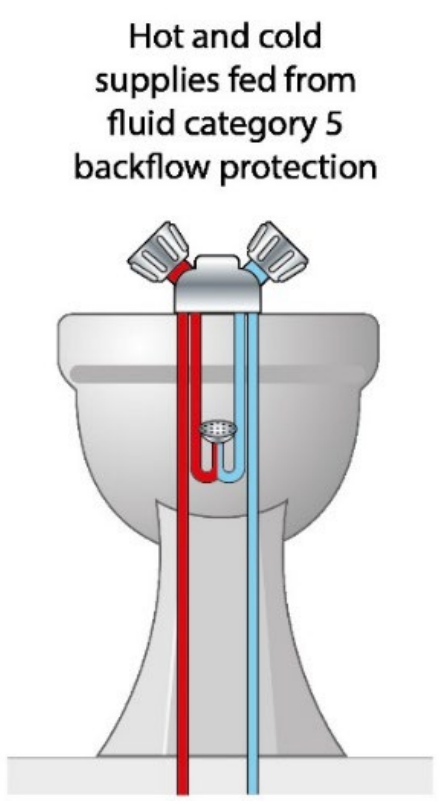All water fittings in a bathroom must be supplied via an appropriate and adequate form of backflow protection, one which is rated either equal to or higher than the highest downstream contamination risk (fluid category) for the type of backflow (back pressure or back siphonage) it is likely to be exposed to.
Typically, bidets are considered to be a fluid category 5 risk, but some designs may be categorised as fluid category 3 in situations where the risk is considered to be lower, for example bidets supplied via taps above the spill over level in typical homes. It is however ultimately for the local water undertaker to determine what level of backflow protection is required.
The installation of a bidet with a hose handset or ascending spray (water outlet submerged i.e. below the bidet spill over level) is notifiable.
If notification is not required, for example because the work is undertaken by an approved contractor, there remains a legal obligation for the premises owner or occupier to ensure the plumbing work is fully compliant with the water fittings regulations, byelaws in Scotland.
Acceptable methods of backflow protection for bidets include:

Both the cold, and where appropriate hot water, supply to a bidet must be supplied via a suitable fluid category 5 backflow prevention arrangement. For example, a break tank incorporating a Type AB air gap.

Providing an acceptable gap can be maintained between the lowest point of the tap outlet and spill over level of the bidet no additional backflow protection is required unless using a mixer tap which combines hot and cold water within the spout (single flow).
The gap required between the tap outlet and bidet spill over level will vary depending upon both the diameter of the pipework supplying the tap(s) and whether the bidet is fluid category 5 (Type AUK3 tap gap) or fluid category 3 (Type AUK2 tap gap).
If the bidet is supplied using single flow mixer tap (as opposed to a dual or bi-flow tap which has separate water paths to the end of the spout) in addition to maintaining the required tap gap single check valves will need to be installed on the pipework supplying the tap. This is to prevent cold water pressurising the hot water and hot water accessing the cold water mains supply under fault conditions.
If the outlet can become submerged, or the required tap gap cannot be maintained, the bidet must be supplied via a suitable form of fluid category 5 backflow protection.
Tap connection size | Minimum tap gap |
Up to and including 15 mm (½”) | 20 mm |
Larger than 15 mm (½”) but smaller than 20 mm (¾”) | 25 mm |
20 mm (¾”) or larger | 70 mm |
20 mm or twice the internal diameter of the tap connection whichever is the greater
For example: tap or shower size | minimum tap gap |
8 mm | 20 mm |
10 mm | 20 mm |
12 mm | 24 mm |
15 mm | 30 mm |
20 mm | 40 mm |
25 mm | 50 mm |
We use cookies to give you the best possible experience with Water Regs UK. Some are essential to provide website functions and ensure the website is secure. We also use cookies to help us understand how people use the site and to make improvements. Click "Accept All" to enable recommended settings or click "Manage cookies" to adjust your settings. For more details, see our Cookie Policy.